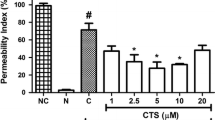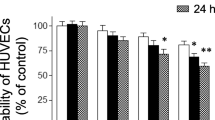Abstract
Sparstolonin B (SsnB) is an isocoumarin compound isolated from the tubers of both Sparganium stoloniferum and Scirpus yagara. We previously demonstrated that SsnB blocked the Toll-like receptor (TLR) 2- and TLR4-triggered inflammatory signaling in macrophages by inhibiting the recruitment of MyD88 to the TIR domains of TLR2 and TLR4. The present study was designed to examine the effects of SsnB on vascular inflammatory responses in human umbilical vein endothelial cells (HUVECs) challenged by lipopolysaccharide (LPS, a TLR4 ligand). We found that SsnB dose-dependently attenuated the LPS-induced expression of interleukin (IL)-1β and monocyte chemoattractant protein 1 both at the transcription and translation levels in HUVEC. LPS-induced endothelial cell adhesion molecules, intercellular adhesion molecular-1 and vascular cell adhesion molecule-1 expressions were also reduced by treatment with SsnB. In addition, co-incubation with SsnB attenuated THP-1 monocyte adhesion to LPS-activated HUVECs. Furthermore, SsnB efficiently suppressed LPS-induced phosphorylation of extracellular -signal-regulated kinase (Erk1/2) and Akt in HUVECs. These findings show that SsnB can suppress endothelial cell inflammation, suggesting that SsnB might be suitable for development as a therapeutic agent for inflammatory cardiovascular disease.




Similar content being viewed by others
References
Altman, R., D.D. Motton, R.S. Kota, and J.C. Rutledge. 2008. Inhibition of vascular inflammation by dehydroepiandrosterone sulfate in human aortic endothelial cells: roles of PPAR alpha and NF-kappa B. Vascular Pharmacology 48: 76–84.
Bains, S.K., R. Foresti, J. Howard, S. Atwal, C.J. Gree, and R. Motterlini. 2010. Human sickle cell blood modulates endothelial heme oxygenase activity: effects on vascular adhesion and reactivity. Arteriosclerosis, Thrombosis, and Vascular Biology 30: 305–312.
Cui, X., Q. Liang, L. Kong, Q. Wu, and J. Duan. 2012. Study on chemical constituents of Scirpus yagara Ohwi. Chinese Pharmaceutical Journal 47: 1987–1989.
Dauphinee, S.M., and A. Karsan. 2006. Lipopolysaccharide signaling in endothelial cells. Laboratory Investigation 86: 9–22.
Dengler, T.J., M.J. Raftery, M. Werle, R. Zimmermann, and G. Schönrich. 2000. Cytomegalovirus infection of vascular cells induces expression of pro-inflammatory adhesion molecules by paracrine action of secreted interleukin-1beta. Transplantation 69: 1160–1168.
Dewberry, R., H. Holden, D. Crossman, and S. Francis. 2000. Interleukin-1 receptor antagonist expression in human endothelial cells and atherosclerosis. Arteriosclerosis, Thrombosis, and Vascular Biology 20: 2394–2400.
Fan, D., S. Qiu, C.D. Overton, P.G. Yancey, L.L. Swift, W.G. Jerome, M.F. Linton, and S. Fazio. 2007. Impaired secretion of apolipoprotein E2 from macrophages. Journal of Biological Chemistry 282: 13746–13753.
Fan, J., and T. Watanabe. 2003. Inflammatory reactions in the pathogenesis of atherosclerosis. Journal of Atherosclerosis and Thrombosis 10: 63–71.
Fotis, L., D. Giannakopoulos, L. Stamogiannou, and M. Xatzipsalti. 2012. Intercellular cell adhesion molecule-1 and vascular cell adhesion molecule-1 in children. Do they play a role in the progression of atherosclerosis? Hormones 11: 140–146.
Hennig, B., L. Wang, X. Arzuaga, D.D. Ghosh, V. Saraswathi, and M. Toborek. 2006. Linoleic acid induces proinflammatory events in vascular endothelial cells via activation of PI3 K/Akt and ERK1/2 signaling. The Journal of Nutritional Biochemistry 17: 766–772.
Iiyama, K., L. Hajra, M. Iiyama, K. Li, M. DiChiara, B.D. Medoff, and M.I. Cybulsky. 1999. Patterns of vascular cell adhesion molecule-1 and intercellular adhesion molecule-1 expression in rabbit and mouse atherosclerotic lesions and at sites predisposed to lesion formation. Circulation Research 85: 199–207.
Liang, Q., Q. Wu, J. Jiang, J. Duan, C. Wang, M.D. Smith, H. Lu, Q. Wang, P. Nagarkatti, and D. Fan. 2011. Characterization of Sparstolonin B, a Chinese herb-derived compound, as a selective toll-like receptor antagonist with potent anti-inflammatory properties. Journal of Biological Chemistry 286: 26470–26479.
Libby, P. 2002. Inflammation in atherosclerosis. Nature 420: 868–874.
Lin, F.S., C.C. Lin, C.S. Chien, S.F. Luo, and C.M. Yang. 2005. Involvement of p42/p44 MAPK, JNK, and NF-kappaB in IL-1beta-induced ICAM-1 expression in human pulmonary epithelial cells. Journal of Cellular Physiology 202: 464–473.
Liu, H.T., J.L. He, W.M. Li, Z. Yang, Y.X. Wang, J. Yin, Y.G. Du, and C. Yu. 2010. Geniposide inhibits interleukin-6 and interleukin-8 production in lipopolysaccharide-induced human umbilical vein endothelial cells by blocking p38 and ERK1/2 signaling pathways. Inflammation Research 59: 451–461.
Moon, L., Y.M. Ha, H.J. Jang, H.S. Kim, M.S. Jun, Y.M. Kim, Y.S. Lee, D.H. Lee, K.H. Son, H.J. Kim, H.G. Seo, J.H. Lee, Y.S. Kim, and K.C. Chang. 2011. Isoimperatorin, cimiside E and 23-O-acetylshengmanol-3- xyloside from Cimicifugae rhizome inhibit TNF-α induced VCAM-1 expression in human endothelial cells: involvement of PPAR-γ upregulation and PI3 K, ERK1/2, and PKC signal pathways. Journal of Ethnopharmacology 133: 336–344.
Raetz, C.R., and C. Whitfield. 2002. Lipopolysaccharide endotoxins. Annual Review of Biochemistry 71: 635–700.
Ross, R. 1999. Atherosclerosis—an inflammatory disease. New England Journal of Medicine 340: 115–126.
Roth, G.A., B. Moser, F. Roth-Walter, M.B. Giacona, E. Harja, P.N. Papapanou, A.M. Schmidt, and E. Lalla. 2007. Infection with a periodontal pathogen increases mononuclear cell adhesion to human aortic endothelial cells. Atherosclerosis 190: 271–281.
Shemesh, S., Y. Kamari, A. Shaish, S. Olteanu, M. Kandel-Kfir, T. Almog, I. Grosskopf, R.N. Apte, and D. Harats. 2011. Interleukin-1 receptor type-1 in non-hematopoietic cells is the target for the pro-atherogenic effects of interleukin-1 in apoE-deficient mice. Atherosclerosis. doi:10.1016/j.atherosclerosis.2011.12.010.
Wang, J., and S. Dong. 2012. ICAM-1 and IL-8 are expressed by DEHP and suppressed by curcumin through ERK and p38 MAPK in human umbilical vein endothelial cells. Inflammation 35: 859–870.
Wiedermann, C.J., S. Kiechl, S. Dunzendorfer, P. Schratzberger, G. Egger, F. Oberhollenzer, and J. Willeit. 1999. Association of endotoxemia with carotid atherosclerosis and cardiovascular disease: prospective results from the bruneck study. Journal of the American College of Cardiology 34: 1975–1981.
**, Z., C. Shan, X. Jiang, X. Luan, and K. Li. 2002. Experimental study on Rhizoma sparganii and Radices zedoariae treating hepatic fibrosis. China Journal of Chinese Materia Medica 27: 929–932.
Yamagami, H., S. Yamagami, T. Inoki, S. Amano, and K. Miyata. 2003. The effects of proinflammatory cytokines on cytokine-chemokine gene expression profiles in the human corneal endothelium. Investigative Ophthalmology & Visual Science 44: 513–520.
Yang, G., L. Zhang, and G. Chen. 2010. Determination of four phenolic compounds in Scirpus yagara Ohwi by CE with amperometric detection. Chromatographia 71: 143–147.
Yoon, J.J., Y.J. Lee, J.S. Kim, D.G. Kang, and H.S. Lee. 2010. Protective role of betulinic acid on TNFα-induced cell adhesion molecules in vascular endothelial cells. Biochemical and Biophysical Research Communications 391: 96–101.
Acknowledgments
This work was supported by the National Natural Science Foundation of China (Grant No. 81173515 and No. 81073002), by the Priority Academic Program Development of Jiangsu Higher Education Institutions, PAPD (ysxk-2010) and by National Institute of Health of USA (P01AT003961 and R21AT006767).
Author information
Authors and Affiliations
Corresponding authors
Rights and permissions
About this article
Cite this article
Liang, Q., Yu, F., Cui, X. et al. Sparstolonin B suppresses lipopolysaccharide-induced inflammation in human umbilical vein endothelial cells. Arch. Pharm. Res. 36, 890–896 (2013). https://doi.org/10.1007/s12272-013-0120-8
Received:
Revised:
Accepted:
Published:
Issue Date:
DOI: https://doi.org/10.1007/s12272-013-0120-8




